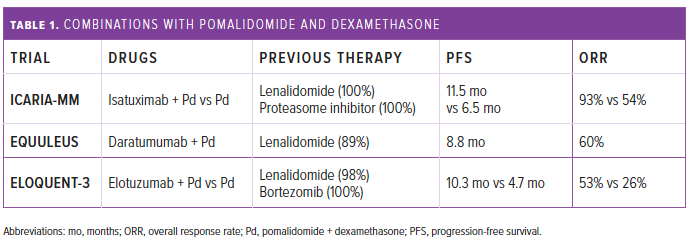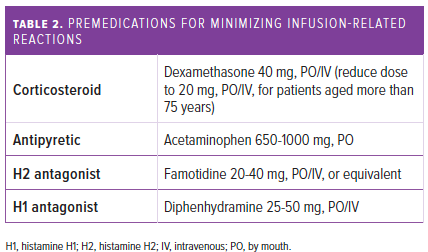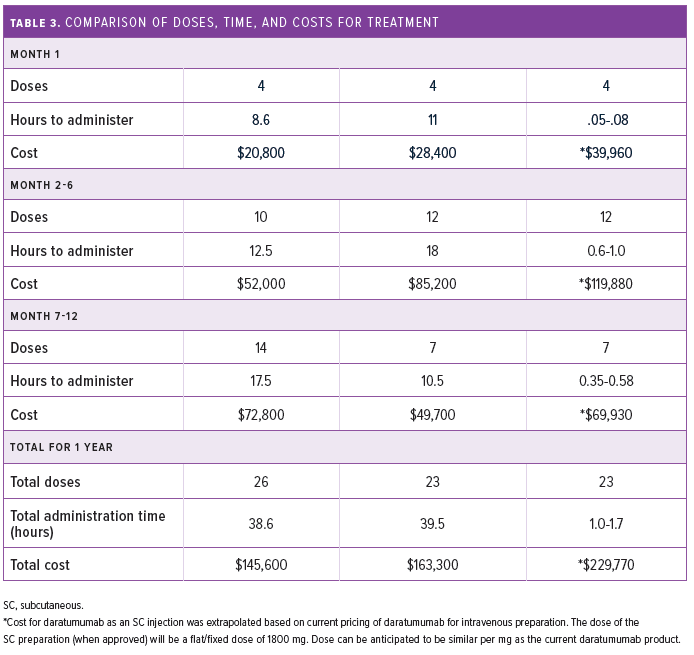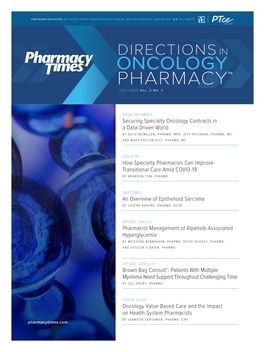Publication
Article
Pharmacy Practice in Focus: Oncology
A New Monoclonal Antibody for R/R MM: Isatuximab-irfc
Isatuximab-ifrc is the third monoclonal antibody approved for the treatment of R/R MM.
Isatuximab-irfc (Sarclisa; Sanofi Pharmaceuticals) received approval by the FDA on March 2, 2020, through an orphan drug designation. Isatuximab-irfc’s approval was indicated for relapsed or refractory (R/R) multiple myeloma (MM) in combination with pomalidomide and dexamethasone in patients who have received at least 2 prior therapies, including a proteasome inhibitor and lenalidomide.1
Treatment of R/R MM
Multiple myeloma remains an incurable disease and requires continuous therapy until disease progression or toxicity develops while on a particular therapy.2 In the past 10 years, a plethora of new agents have become available to treat R/R MM, and increasing evidence suggests that combining these agents in triplet combinations is the best strategy to maximize the depth of response required for longest remission and/or minimal residual disease in patients who can tolerate it.3
Isatuximab-ifrc was approved by the FDA based on results from the ICARIA-MM trial. ICARIA-MM was an open-label, multicenter, randomized, phase 3 trial that enrolled patients with R/R MM with previous treatment with lenalidomide and any proteasome inhibitor (bortezomib, carfilzomib, or ixazomib). Patients were randomized to isatuximab in combination with pomalidomide and dexamethasone or to pomalidomide and dexamethasone alone (Pd). The dose of pomalidomide was 4 mg by mouth for 21 days, then 7 days off, and dexamethasone was dosed at 40 mg by mouth or intravenously once weekly (20 mg for patients aged more than 75 years). All patients were placed on aspirin or low molecular weight heparin for venous thromboembolism prophylaxis.
Progression-free survival was significantly longer in the isatuximab group than in the Pd group (11.5 vs 6.5 months). Furthermore, overall response rates were higher in the isatuximab arm (93% vs 53%). The patients treated with isatuximab also had deeper responses (ie, more very good partial responses or better) than those receiving Pd alone. The results were consistent across all predefined subgroups.
Isatuximab-ifrc is the third monoclonal antibody approved for the treatment of R/R MM, joining daratumumab (Darzalex) and elotuzumab (Empliciti). In the relapsed setting, all 3 have been evaluated in combination with pomalidomide and dexamethasone.4-6
Based on the MM-003 trial,7 pomalidomide in combination with dexamethasone had become a standard-of-care option in patients whose disease was refractory to other agents. Therefore, adding a novel agent to this combination was performed in 3 trials (Table 1).

Although these agents and combinations cannot be compared against one another, the results in these groups, which had similar study populations, yielded comparable outcomes. All 3 trials had pretreatment with lenalidomide and proteasome inhibitors. Furthermore, when Pd was used as a comparator arm, the results were similar to results seen in MM-003; this strengthens the data outcomes.
Mechanism of Action
Isatuximab-ifrc is a human monoclonal antibody that targets CD38, heavily expressed on multiple myeloma cells. It induces antitumor activity via antibody-dependent, cell-mediated cytotoxicity and complement-dependent cytotoxicity.8
Dosage and Administration8
Isatuximab-ifrc is commercially available as an intravenous solution of 100-mg/5-mL and 500-mg/25-mL vials. The vials should be stored in a refrigerator at 36 °F to 46 °F (2 °C-8 °C) in the original carton protected from light. The medication should not be frozen or shaken. The dose of isatuximab-ifrc is 10 mg/kg dosed on actual body weight. It is administered intravenously weekly for 4 consecutive weeks followed by every 2 weeks in combination with pomalidomide and dexamethasone until disease progression. The premedications in Table 2 should be administered 15 to 60 minutes prior to isatuximab-ifrc infusion to minimize the risk for infusion-related reactions.

To minimize the risk of infusion reaction, isatuximab-ifrc is administered slowly (for the first dose) at a rate of 25 mL/hr for 60 minutes, then increased by 25 mL/hr every 30 minutes to a maximum rate of 150 mL/hr. The second infusion may be initiated at 50 mL/hr for 30 minutes and increased by 50 mL/hr for 30 minutes, then by 100 mL/hr every 30 minutes to a maximum rate of 200 mL/hr. Third and subsequent infusions may be initiated at 200 mL/hr and administered over 75 minutes. Median infusion time for isatuximab was 3.3 hours for the first infusion and 2.8 hours for subsequent ones.4
Warnings, Precautions, and Adverse Reactions
The most common adverse reaction observed in the ICARIA-MM trial was infusion reaction, occurring in 38% of patients treated with isatuximab. Of note, 98% of all infusion reactions were during the first infusion and were reversible. Subsequently, no delayed infusion reactions were reported in days following isatuximab infusion, despite no postinfusion prophylaxis being recommended. Four patients (3%) experienced a grade 3 or 4 infusion reaction. The most common symptoms reported for infusion reactions were chills, nausea, cough, dyspnea, and dyspnea with severe symptoms including hypertension.
Other common adverse effects reported with isatuximab were neutropenia in 96% of patients (85% grade 3 or 4), thrombocytopenia in 84%, and anemia in 99%. However, it is important to note that similar incidences of hematologic toxicity were seen in the Pd group in the ICARIA-MM trial. Granulocyte colony-stimulating factor (G-CSF) was used in 67% of patients treated in the isatuximab group and 53% of patients treated in the Pd group. Overall, there were no differences in numbers of platelet transfusions or hemorrhages between treatment groups.
Cost
The wholesale acquisition cost of isatuximab-ifrc in the United States is $3250 for a 25-mL vial (20 mg/ mL) and $650 for a 5-mL vial (approximately $130 per 20 mg of drug).9 Extrapolated to an 80-kg patient for a 12-month (52-week) treatment course, total cost would be approximately $145,600. Total cost for daratumumab is approximately $163,300 for a 12-month course.
It should be noted that the costs listed are not what patients pay, and they may be lower due to contracting and rebate models through individual organizations.
Comparison With Other Anti-CD38 Monoclonal Antibodies and Future Direction
Isatuximab-ifrc is the second FDA approved anti-CD38 monoclonal antibody available on the market, following daratumumab. The dosing schedule, time of administration, and total cost is variable between isatuximab-ifrc and daratumumab. Furthermore, a subcutaneous formulation of daratumumab is currently under investigation, and FDA approval is anticipated in 2020.
Table 3 is a side-by-side comparison of projected doses, administration times, and costs for a hypothetical patient weighing 80 kilograms who is treated for 12 months (52 weeks).

DAVID HUGHES, PHARMD, BCOP is a clinical pharmacy specialist in Hematology/Oncology and a pharmacy resident preceptor at Boston Medical Center in Massachusetts.FRANCES R. BLEVINS, PA-C (Hematology- Oncology) is an instructor of medicine at Boston University School of Medicine in Massachusetts.
REFERENCES
- FDA approves isatuximab-ifrc for multiple myeloma. FDA. March 2, 2020. Accessed April 4, 2020. https://www.fda.gov/drugs/development-approval-process-drugs/fda-approves-isatuximab-irfc-multiple-myeloma
- Rajkumar SV, Kumar S. Multiple myeloma: diagnosis and treatment. Mayo Clin Proc. 2016;91(1):101-119. doi:10.1016/j.mayocp.2015.11.007
- Offidani M, Corvatta L, Gentili S. Triplet vs. doublet drug regimens for managing multiple myeloma. Expert Opin Pharmacother. 2018;19(2):137-149. doi:10.1080/14656566.2017.1418856
- Attal M, Richardson P, Rajkumar SV, et al. Isatuximab plus pomalidomide and low-dose dexamethasone versus pomalidomide and low-dose dexamethasone in patients with relapsed and refractory multiple myeloma (ICARIA-MM): a randomised, multicentre, open-label, phase 3 study. Lancet. 2019;394(10214):2096-2107. doi:10.1016/S0140-6736(19)32556-5
- Chari A, Suvannasankha A, Fay JW, et al. Daratumumab plus pomalidomide and dexamethasone in relapsed and/or refractory multiple myeloma. Blood. 2017;130(8): 974-981. doi:10.1182/blood-2017-05-785246
- Dimopoulos MA, Dytfeld D, Grosicki S, et al. Elotuzumab plus pomalidomide and dexamethasone for multiple myeloma. N Engl J Med. 2018;379(19):1811-1822. doi:10.1056/NEJMoa1805762
- San Miguel J, Weisel K, Moreau P, et al. Pomalidomide plus low-dose dexamethasone versus high-dose dexamethasone alone for patients with relapsed and refractory multiple myeloma (MM-003): a randomised, open-label, phase 3 trial. Lancet Oncol. 2013;14(11):1055-1066. doi:10.1016/S1470-2045(13)70380-2
- Sarclisa (isatuximab-irfc). Prescribing information. Sanofi Pharmaceuticals; 2020. Accessed June 11, 2020. https://www.accessdata.fda.gov/drugsatfda_docs/label/2020/761113s000lbl.pdf
- FDA approves Sarclisa (isatuximab-ifrc) for patients with relapsed refractory multiple myeloma. News release. Sanofi Pharmaceuticals; March 2, 2020. Accessed April 5, 2020. https://www.sanofi.com/en/media-room/press-releases/2020/2020-03-02-19-51-16






